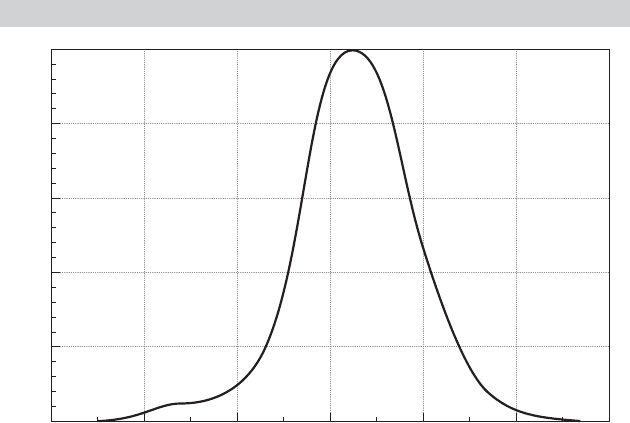Greene W.H. Econometric Analysis
Подождите немного. Документ загружается.


CHAPTER 15
✦
Simulation-Based Estimation and Inference
649
The third and fourth models in Table 15.8 present the mixed model estimates. The first of
them imposes the restriction that
21
= 0, or that the two random parameters are uncorre-
lated. The second mixed model allows
21
to be a free parameter. The implied estimators
for σ
u1
, σ
u2
and σ
u,21
are the elements of
,or
σ
2
u1
=
2
11
,
σ
u,21
=
11
21
,
σ
2
u2
=
2
21
+
2
22
.
These estimates are shown separately in the table. Note that in all three random parame-
ters models (including the random effects model which is equivalent to the mixed model
with all α
Im
= 0 save for α
1,1
and α
2,1
as well as
21
=
22
= 0.0), the estimate of
σ
ε
is relatively unchanged. The three models decompose the variation across groups in
the parameters differently, but the overall variation of the dependent variable is largely the
same.
The interesting coefficient in the model is β
2,i
. Reading across the row for Educ, one
might suspect that the random parameters model has washed out the impact of education,
since the “coefficient” declines from 0.04072 to 0.007607. However, in the mixed models,
the “mean” parameter, α
2,1
, is not the coefficient of interest. The coefficient on education in
the model is β
2,i
= α
2,1
+α
2,2
Ability +β
2,3
Mother’s education +β
2,4
Father’s education +u
2,i
.
A rough indication of the magnitude of this result can be seen by inserting the sample means
for these variables, 0.052374, 11.4719, and 11.7092, respectively. With these values, the
mean value for the education coefficient is approximately 0.0327. This is comparable, though
somewhat smaller, than the estimates for the pooled and random effects model. Of course,
variation in this parameter across the sample individuals was the objective of this specifica-
tion. Figure 15.9 plots a kernel density estimate for the estimated conditional means for the
2,178 sample individuals. The figure shows the very wide range of variation in the sample
estimates.
FIGURE 15.9
Kernel Density Estimate for Education Coefficient.
0.000 0.010 0.020 0.0400.030

Educ, i
Density
66
0.050 0.060
53
40
26
13
0
650
PART III
✦
Estimation Methodology
15.11 MIXED MODELS AND LATENT CLASS
MODELS
Sections 15.7–15-10 examined different approaches to modeling parameter heterogene-
ity. The fixed effects approach begun in Section 11.4 is extended to include the full set
of regression coefficients in Section 11.11.1. where
y
i
= X
i
β
i
+ ε
i
,
β
i
= β + u
i
and no restriction is placed on E[u
i
|X
i
]. Estimation produces a feasible GLS estimate
of β. Estimation of β begins with separate least squares estimation with each group,
i—because of the correlation between u
i
and x
it
, the pooled estimator is not consis-
tent. The efficient estimator of β is then a mixture of the bi’s. We also examined an
estimator of β
i
, using the optimal predictor from the conditional distributions, (15-39).
The crucial assumption underlying the analysis is the possible correlation between X
i
and u
i
. We also considered two modifications of this random coefficients model. First,
a restriction of the model in which some coefficients are nonrandom provides a useful
simplification. The familiar fixed effects model of Section 11.4 is such a case, in which
only the constant term varies across individuals. Second, we considered a hierarchical
form of the model
β
i
= β + z
i
+ u
i
. (15-42)
This approach is applied to an analysis of mortgage rates in Example 11.20. [Pl ¨umper
and Troeger’s (2007) FEVD estimator examined in Section 11.4.5 is essentially this
model as well.]
A second approach to random parameters modeling builds from the crucial assump-
tion added to (15-42) that u
i
and X
i
are uncorrelated. The general model is defined in
terms of the conditional density of the random variable, f (y
it
|x
it
, β
i
, θ ), and the marginal
density of the random coefficients, f (β
i
|z
i
, ), in which is the separate parameters of
this distribution. This leads to the mixed models examined in this chapter. The random
effects model that we examined in Section 11.5 and several other points is a special
case in which only the constant term is random (like the fixed effects model). We also
considered the specific case in which u
i
is distributed normally with variance σ
2
u
.
A third approach to modeling heterogeneity in parametric models is to use a
discrete distribution, either as an approximation to an underlying continuous distri-
bution, or as the model of the data generating process in its own right. (See Sec-
tion 14.10.) This model adds to the preceding a nonparametric specification of the
variation in β
i
,
Prob(β
i
= β
j
|z
i
) = π
j
, j = 1,..., J.
A somewhat richer, semiparametric form that mimics (15-42) is
Prob(β
i
= β
j
|z
i
) = π
j
(z
i
, ), j = 1,...,J.
We continue to assume that the process generating variation in β
i
across individuals is
independent of the process that produces X
i
—that is, in a broad sense, we retain the
random effects approach. This latent class model is gaining popularity in the current

CHAPTER 15
✦
Simulation-Based Estimation and Inference
651
TABLE 15.9
Estimated Random Parameters Model
Probit RP Mean RP Std. Dev. Empirical Distn.
Constant −1.96 −3.91 2.70 −3.27
(0.23) (0.20) (0.57)
In Sales 0.18 0.36 0.28 0.32
(0.022) (0.019) (0.15)
Relative Size 1.07 6.01 5.99 3.33
(0.14) (0.22) (2.25)
Import 1.13 1.51 0.84 2.01
(0.15) (0.13) (0.58)
FDI 2.85 3.81 6.51 3.76
(0.40) (0.33) (1.69)
Productivity −2.34 −5.10 13.03 −8.15
(0.72) (0.73) (8.29)
Raw materials −0.28 −0.31 1.65 −0.18
(0.081) (0.075) (0.57)
Investment 0.19 0.27 1.42 0.27
(0.039) (0.032) (0.38)
ln L −4114.05 −3498.654
literature. In the last example of this chapter, we will examine a comparison of mixed
and finite mixture models for a nonlinear model.
Example 15.17 Maximum Simulated Likelihood Estimation of a Binary
Choice Model
Bertschek and Lechner (1998) analyzed the product innovations of a sample of German
manufacturing firms. They used a probit model (Sections 17.2–17.4) to study firm innovations.
The model is for Prob[y
it
= 1|x
it
, β
i
] where
y
it
= 1iffirmi realized a product innovation in year t and 0 if not.
The independent variables in the model are
X
it,1
= constant,
X
it,2
= log of sales,
X
it,3
= relative size = ratio of employment in business unit to employment in the industry,
X
it,4
= ratio of industry imports to (industry sales + imports),
X
it,5
= ratio of industry foreign direct investment to (industry sales + imports),
X
it,6
= productivity = ratio of industry value added to industry employment,
X
it,7
= dummy variable indicating firm is in the raw materials sector,
X
it,8
= dummy variable indicating firm is in the investment goods sector.
The sample consists of 1,270 German firms observed for five years, 1984–1988. (See Ap-
pendix Table F15.1.) The density that enters the log-likelihood is
f ( y
it
|x
it
, β
i
) = Prob[ y
it
|x
it
β
i
] = [(2y
it
− 1)x
it
β
i
], y
it
= 0, 1,
where
β
i
= β + v
i
, v
i
∼ N[0, ].
To be consistent with Bertschek and Lechner (1998) we did not fit any firm-specific time-
invariant components in the main equation for β
i
.
9
Table 15.9 presents the estimated
9
Apparently they did not use the second derivatives to compute the standard errors—we could not replicate
these. Those shown in the Table 15.9 are our results.

652
PART III
✦
Estimation Methodology
TABLE 15.10
Estimated Latent Class Model
Class 1 Class 2 Class 3 Posterior
Constant −2.32 −2.71 −8.97 −3.38
(0.59) (0.69) (2.20) (2.14)
In Sales 0.32 0.23 0.57 0.34
(0.061) (0.072) (0.18) (0.09)
Relative Size 4.38 0.72 1.42 2.58
(0.89) (0.37) (0.76) (1.30)
Import 0.94 2.26 3.12 1.81
(0.37) (0.53) (1.38) (0.74)
FDI 2.20 2.81 8.37 3.63
(1.16) (1.11) (1.93) (1.98)
Productivity −5.86 −7.70 −0.91 −5.48
(2.70) (4.69) (6.76) (1.78)
Raw Materials −0.11 −0.60 0.86 −0.08
(0.24) (0.42) (0.70) (0.37)
Investment 0.13 0.41 0.47 0.29
(0.11) (0.12) (0.26) (0.13)
ln L −3503.55
Class Prob (Prior) 0.469 0.331 0.200
(0.0352) (0.0333) (0.0246)
Class Prob (Posterior) 0.469 0.331 0.200
(0.394) (0.289) (0.325)
Pred. Count 649 366 255
coefficients for the basic probit model in the first column. These are the values reported
in the 1998 study. The estimates of the means, β, are shown in the second column. There
appear to be large differences in the parameter estimates, although this can be misleading as
there is large variation across the firms in the posterior estimates. The third column presents
the square roots of the implied diagonal elements of computed as the diagonal elements of
CC
. These estimated standard deviations are for the underlying distribution of the parameter
in the model—they are not estimates of the standard deviation of the sampling distribution of
the estimator. That is shown for the mean parameter in the second column. The fourth col-
umn presents the sample means and standard deviations of the 1,270 estimated conditional
estimates of the coefficients.
The latent class formulation developed in Section 14.10 provides an alternative approach
for modeling latent parameter heterogeneity.
10
To illustrate the specification, we will reesti-
mate the random parameters innovation model using a three-class latent class model. Esti-
mates of the model parameters are presented in Table 15.10. The estimated conditional mean
shown, which is comparable to the empirical means in the rightmost column in Table 15.9 for
the random parameters model, are the sample average and standard deviation of the 1,270
firm-specific posterior mean parameter vectors. They are computed using
ˆ
β
i
=
3
j =1
ˆπ
ij
ˆ
β
j
where ˆπ
ij
is the conditional estimator of the class probabilities in (14-102). These estimates
differ considerably from the probit model, but they are quite similar to the empirical means in
Table 15.9. In each case, a confidence interval around the posterior mean contains the one-
class pooled probit estimator. Finally, the (identical) prior and average of the sample posterior
class probabilities are shown at the bottom of the table. The much larger empirical standard
deviations reflect that the posterior estimates are based on aggregating the sample data and
involve, as well, complicated functions of all the model parameters. The estimated numbers
of class members are computed by assigning to each firm the predicted class associated
with the highest posterior class probability.
10
See Greene (2001) for a survey. For two examples, Nagin and Land (1993) employed the model to study
age transitions through stages of criminal careers and Wang et al. (1998) and Wedel et al. (1993) used the
Poisson regression model to study counts of patents.

CHAPTER 15
✦
Simulation-Based Estimation and Inference
653
15.12 SUMMARY AND CONCLUSIONS
This chapter has outlined several applications of simulation-assisted estimation and
inference. The essential ingredient in any of these applications is a random number
generator. We examined the most common method of generating what appear to be
samples of random draws from a population—in fact, they are deterministic Markov
chains that only appear to be random. Random number generators are used directly to
obtain draws from the standard uniform distribution. The inverse probability transfor-
mation is then used to transform these to draws from other distributions. We examined
several major applications involving random sampling:
•
Random sampling, in the form of bootstrapping, allows us to infer the characteris-
tics of the sampling distribution of an estimator, in particular its asymptotic variance.
We used this result to examine the sampling variance of the median in random sam-
pling from a nonnormal population. Bootstrapping is also a useful, robust method
of constructing confidence intervals for parameters.
•
Monte Carlo studies are used to examine the behavior of statistics when the precise
sampling distribution of the statistic cannot be derived. We examined the behavior
of a certain test statistic and of the maximum likelihood estimator in a fixed effects
model.
•
Many integrals that do not have closed forms can be transformed into expectations
of random variables that can be sampled with a random number generator. This
produces the technique of Monte Carlo integration. The technique of maximum
simulated likelihood estimation allows the researcher to formulate likelihood func-
tions (and other criteria such as moment equations) that involve expectations that
can be integrated out of the function using Monte Carlo techniques. We used the
method to fit random parameters models.
The techniques suggested here open up a vast range of applications of Bayesian statis-
tics and econometrics in which the characteristics of a posterior distribution are de-
duced from random samples from the distribution, rather than brute force derivation
of the analytic form. Bayesian methods based on this principle are discussed in the next
chapter.
Key Terms and Concepts
•
Antithetic draws
•
Block bootstrap
•
Bootstrapping
•
Cholesky decomposition
•
Cholesky factorization
•
Delta method
•
Direct product
•
Discrete uniform
distribution
•
Fundamental probability
transformation
•
Gauss–Hermite quadrature
•
GHK smooth recursive
stimulator
•
Hadamard product
•
Halton draws
•
Hierarchical linear
model
•
Incidental parameters
problem
•
Kronecker product
•
Markov chain
•
Maximum stimulated
likelihood
•
Mixed model
•
Monte Carlo integration
•
Monte Carlo study
•
Nonparametric bootstrap
•
Paired bootstrap
•
Parametric bootstrap
•
Percentile method
•
Period
•
Poisson
•
Power of a test
•
Pseudo maximum likelihood
estimator

654
PART III
✦
Estimation Methodology
•
Pseudo–random number
generator
•
Random parameters
•
Schur product
•
Seed
•
Simulation
•
Size of a test
•
Specificity
•
Shuffling
Exercises
1. Theexponential distribution has density f (x) = θ exp(−θ x). How would you obtain
a random sample of observations from an exponential population?
2. TheWeibull population has survival function S(x) = λp exp(−(λx) p). How would
you obtain a random sample of observations from a Weibull population? (The
survival function equals one minus the cdf.)
3. Derive the first order conditions for nonlinear least squares estimation of the pa-
rameters in (15-2). How would you estimate the asymptotic covariance matrix for
your estimator of θ = (β, σ )?
Applications
1. Does the Wald statistic reject the null hypothesis too often? Construct a Monte
Carlo study of the behavior of the Wald statistic for testing the hypothesis that γ
equals zero in the model of Section 15.5.1. Recall, theWald statistic is the square
of the t ratio on the parameter in question. The procedure of the test is to reject
the null hypothesis if the Wald statistic is greater than 3.84, the critical value from
the chi-squared distribution with one degree of freedom. Replicate the study in
Section 15.5.1 that is for all three assumptions about the underlying data.
2. A regression model that describes income as a function of experience is
ln Income
i
= β
1
+ β
2
Experience
i
+ β
3
Experience
2
i
+ ε
i
.
The model implies that ln Income is largest when ∂ ln Income/∂ Experience equals
zero. The value of Experience at which this occurs is where β
4
+2β
5
Experience = 0,
or Experience* =−β
2
/β
3
. Describe how to use the delta method to obtain a con-
fidence interval for Experience*. Now, describe how to use bootstrapping for this
computation. A model of this sort using the Cornwell and Rupert data appears
in Example 15.6. Using your proposals here, carry out the computations for that
model using the Cornwell and Rupert data.

16
BAYESIAN ESTIMATION
AND INFERENCE
Q
16.1 INTRODUCTION
The preceding chapters (and those that follow this one) are focused primarily on para-
metric specifications and classical estimation methods. These elements of the economet-
ric method present a bit of a methodological dilemma for the researcher. They appear
to straightjacket the analyst into a fixed and immutable specification of the model. But
in any analysis, there is uncertainty as to the magnitudes, sometimes the signs and, at
the extreme, even the meaning of parameters. It is rare that the presentation of a set
of empirical results has not been preceded by at least some exploratory analysis. Pro-
ponents of the Bayesian methodology argue that the process of “estimation” is not one
of deducing the values of fixed parameters, but rather, in accordance with the scientific
method, one of continually updating and sharpening our subjective beliefs about the
state of the world. Of course, this adherence to a subjective approach to model building
is not necessarily a virtue. If one holds that “models” and “parameters” represent objec-
tive truths that the analyst seeks to discover, then the subjectivity of Bayesian methods
may be less than perfectly comfortable.
Contemporary applications of Bayesian methods typically advance little of this the-
ological debate. The modern practice of Bayesian econometrics is much more pragmatic.
As we will see in several of the following examples, Bayesian methods have produced
some remarkably efficient solutions to difficult estimation problems. Researchers often
choose the techniques on practical grounds, rather than in adherence to their philo-
sophical basis; indeed, for some, the Bayesian estimator is merely an algorithm.
1
Bayesian methods have have been employed by econometricians since well be-
fore Zellner’s classic (1971) presentation of the methodology to economists, but un-
til fairly recently, were more or less at the margin of the field. With recent advances
in technique (notably the Gibbs sampler) and the advance of computer software and
hardware that has made simulation-based estimation routine, Bayesian methods
that rely heavily on both have become widespread throughout the social sciences.
There are libraries of work on Bayesian econometrics a rapidly expanding applied
1
For example, from the home Web site of MLWin, a widely used program for multilevel (random parameters)
modeling, http://www.cmm.bris.ac.uk/MLwiN/features/mcmc.shtml, we find “Markov Chain Monte Carlo
(MCMC) methods allow Bayesian models to be fitted, where prior distributions for the model parameters
are specified. By default MLwiN sets diffuse priors which can be used to approximate maximum likelihood
estimation.” Train (2001) is an interesting application that compares Bayesian and classical estimators of a
random parameters model.
655

656
PART III
✦
Estimation Methodology
literature.
2
This chapter will introduce the vocabulary and techniques of Bayesian
econometrics. Section 16.2 lays out the essential foundation for the method. The canon-
ical application, the linear regression model, is developed in Section 16.3. Section 16.4
continues the methodological development. The fundamental tool of contemporary
Bayesian econometrics, the Gibbs sampler, is presented in Section 16.5. Three appli-
cations and several more limited examples are presented in Sections 16.6, 16.7, and
16.8. Section 16.6 shows how to use the Gibbs sampler to estimate the parameters of
a probit model without maximizing the likelihood function. This application also in-
troduces the technique of data augmentation. Bayesian counterparts to the panel data
random and fixed effects models are presented in Section 16.7. A hierarchical Bayesian
treatment of the random parameters model is presented in Section 16.8 with a com-
parison to the classical treatment of the same model. Some conclusions are drawn in
Section 16.9. The presentation here is nontechnical. A much more extensive entry level
presentation is given by Lancaster (2004). Intermediate-level presentations appear in
Cameron and Trivedi (2005, Chapter 13), and Koop (2003). A more challenging treat-
ment is offered in Geweke (2005). The other sources listed in footnote 2 are oriented
to applications.
16.2 BAYES THEOREM AND THE
POSTERIOR DENSITY
The centerpiece of the Bayesian methodology is the Bayes’s theorem: for events Aand
B, the conditional probability of event A given that B has occurred is
P(A|B) =
P(B |A)P(A)
P(B)
. (16-1)
Paraphrased for our applications here, we would write
P(parameters |data) =
P(data |parameters)P(parameters)
P(data)
.
In this setting, the data are viewed as constants whose distributions do not involve the
parameters of interest. For the purpose of the study, we treat the data as only a fixed
set of additional information to be used in updating our beliefs about the parameters.
Note the similarity to (12-1). Thus, we write
P(parameters |data) ∝ P(data |parameters)P(parameters)
(16-2)
= Likelihood function ×Prior density.
The symbol ∝ means “is proportional to.” In the preceding equation, we have dropped
the marginal density of the data, so what remains is not a proper density until it is scaled
by what will be an inessential proportionality constant. The first term on the right is
the joint distribution of the observed random variables y, given the parameters. As we
2
Recent additions to the dozens of books on the subject include Gelman et al. (2004), Geweke (2005), Gill
(2002), Koop (2003), Lancaster (2004), Congdon (2005), and Rossi et al. (2005). Readers with a historical bent
will find Zellner (1971) and Leamer (1978) worthwhile reading. There are also many methodological surveys.
Poirier and Tobias (2006) as well as Poirier (1988, 1995) sharply focus the nature of the methodological
distinctions between the classical (frequentist) and Bayesian approaches.

CHAPTER 16
✦
Bayesian Estimation and Inference
657
shall analyze it here, this distribution is the normal distribution we have used in our
previous analysis—see (12-1). The second term is the prior beliefs of the analyst. The
left-hand side is the posterior density of the parameters, given the current body of data,
or our revised beliefs about the distribution of the parameters after “seeing” the data.
The posterior is a mixture of the prior information and the “current information,” that
is, the data. Once obtained, this posterior density is available to be the prior density
function when the next body of data or other usable information becomes available. The
principle involved, which appears nowhere in the classical analysis, is one of continual
accretion of knowledge about the parameters.
Traditional Bayesian estimation is heavily parameterized. The prior density and the
likelihood function are crucial elements of the analysis, and both must be fully specified
for estimation to proceed. The Bayesian “estimator” is the mean of the posterior density
of the parameters, a quantity that is usually obtained either by integration (when closed
forms exist), approximation of integrals by numerical techniques, or by Monte Carlo
methods, which are discussed in Section 15.6.2.
Example 16.1 Bayesian Estimation of a Probability
Consider estimation of the probability that a production process will produce a defective
product. In case 1, suppose the sampling design is to choose N = 25 items from the
production line and count the number of defectives. If the probability that any item is defec-
tive is a constant θ between zero and one, then the likelihood for the sample of data is
L( θ |data) = θ
D
(1− θ )
25−D
,
where D is the number of defectives, say, 8. The maximum likelihood estimator of θ will
be p = D/25 = 0.32, and the asymptotic variance of the maximum likelihood estimator is
estimated by p(1− p) /25 = 0.008704.
Now, consider a Bayesian approach to the same analysis. The posterior density is obtained
by the following reasoning:
p( θ |data) =
p( θ, data)
p( data)
=
p( θ, data)
&
θ
p( θ, data)dθ
=
p( data |θ) p( θ)
p( data)
=
Likelihood( data |θ) × p(θ )
p( data)
where p(θ ) is the prior density assumed for θ . [We have taken some license with the termi-
nology, since the likelihood function is conventionally defined as L( θ |data) .] Inserting the
results of the sample first drawn, we have the posterior density:
p( θ |data) =
θ
D
(1− θ )
N−D
p( θ)
&
θ
θ
D
(1− θ )
N−D
p( θ)dθ
.
What follows depends on the assumed prior for θ. Suppose we begin with a “noninforma-
tive” prior that treats all allowable values of θ as equally likely. This would imply a uniform
distribution over (0,1). Thus, p( θ) = 1, 0 ≤ θ ≤ 1. The denominator with this assumption is
a beta integral (see Section E2.3) with parameters a = D + 1 and b = N − D + 1, so the
posterior density is
p( θ |data) =
θ
D
(1− θ )
N−D
( D + 1)( N − D + 1)
( D + 1 + N − D + 1)
=
( N + 2) θ
D
(1− θ )
N−D
( D + 1)( N − D + 1)
.
This is the density of a random variable with a beta distribution with parameters (α, β) =
( D +1, N −D +1). (See Section B.4.6.) The mean of this random variable is ( D +1)/( N +2) =
9/27 = 0.3333 (as opposed to 0.32, the MLE). The posterior variance is [( D +1)/( N −D +1)]/
[( N + 3)( N + 2)
2
] = 0.007936.

658
PART III
✦
Estimation Methodology
There is a loose end in this example. If the uniform prior were noninformative, that would
mean that the only information we had was in the likelihood function. Why didn’t the Bayesian
estimator and the MLE coincide? The reason is that the uniform prior over [0,1] is not really
noninformative. It did introduce the information that θ must fall in the unit interval. The prior
mean is 0.5 and the prior variance is 1/12. The posterior mean is an average of the MLE and
the prior mean. Another less than obvious aspect of this result is the smaller variance of the
Bayesian estimator. The principle that lies behind this (aside from the fact that the prior did in
fact introduce some certainty in the estimator) is that the Bayesian estimator is conditioned
on the specific sample data. The theory behind the classical MLE implies that it averages
over the entire population that generates the data. This will always introduce a greater degree
of “uncertainty” in the classical estimator compared to its Bayesian counterpart.
16.3 BAYESIAN ANALYSIS OF THE CLASSICAL
REGRESSION MODEL
The complexity of the algebra involved in Bayesian analysis is often extremely bur-
densome. For the linear regression model, however, many fairly straightforward results
have been obtained. To provide some of the flavor of the techniques, we present the full
derivation only for some simple cases. In the interest of brevity, and to avoid the burden
of excessive algebra, we refer the reader to one of the several sources that present the
full derivation of the more complex cases.
3
The classical normal regression model we have analyzed thus far is constructed
around the conditional multivariate normal distribution N[Xβ,σ
2
I]. The interpreta-
tion is different here. In the sampling theory setting, this distribution embodies the
information about the observed sample data given the assumed distribution and the
fixed, albeit unknown, parameters of the model. In the Bayesian setting, this function
summarizes the information that a particular realization of the data provides about the
assumed distribution of the model parameters. To underscore that idea, we rename this
joint density the likelihood for β and σ
2
given the data,so
L(β,σ
2
|y, X) = [2πσ
2
]
−n/2
e
−[(1/(2σ
2
))(y−Xβ)
(y−Xβ)]
. (16-3)
For purposes of the following results, some reformulation is useful. Let d = n − K (the
degrees of freedom parameter), and substitute
y − Xβ = y − Xb − X(β −b) = e − X(β −b)
in the exponent. Expanding this produces
−
1
2σ
2
(y − Xβ)
(y − Xβ) =
−
1
2
ds
2
1
σ
2
−
1
2
(β − b)
1
σ
2
X
X
(β − b).
After a bit of manipulation (note that n/2 = d/2 + K/2), the likelihood may be written
L(β,σ
2
|y, X)
= [2π]
−d/2
[σ
2
]
−d/2
e
−(d/2)(s
2
/σ
2
)
[2π]
−K/2
[σ
2
]
−K/2
e
−(1/2)(β−b)
[σ
2
(X
X)
−1
]
−1
(β−b)
.
3
These sources include Judge et al. (1982, 1985), Maddala (1977a), Mittelhammer et al. (2000), and the
canonical reference for econometricians, Zellner (1971). A remarkable feature of the current literature is the
degree to which the analytical components have become ever simpler while the applications have become
progressively more complex. This will become evident in Sections 16.5–16.7.
